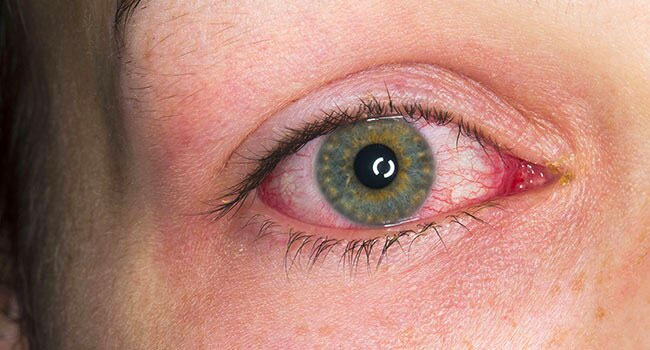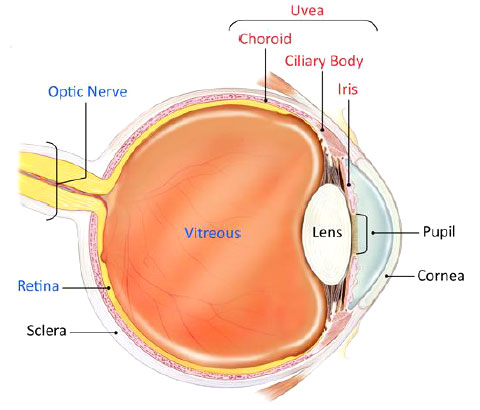Uveitis
Uveitis refers to a group of eye diseases whereby the middle layer of the eyeball called the “uvea” gets inflamed (red and swollen). It can cause acutely painful red eye or more gradual onset of visual difficulties including blurred vision and floaters. Uveitis can affect all age groups from children to young adults and older persons.
What are the symptoms of uveitis?

Image from WebMD: A visual guide to uveitis
Uveitis can cause a wide range of symptoms that can come on quickly (over a few days) or of a more gradual onset (over weeks and months). It can affect one or both eyes. Symptoms of uveitis can include:
- Having a red and/or painful eye
- Being very sensitive to bright light (photosensitivity)
- Blurry vision or acute loss of eyesight
- Seeing new “floaters” (shaped like specks or cobwebs moving in your vision)
Types of uveitis
Uveitis is classified into 4 main types by eye specialists, according to the main site within the eye that becomes inflamed:
1. Anterior uveitis: Inflammation affects the front part of the eye (the iris) and usually has acute onset of symptoms with painful red eye occurring within days. Anterior uveitis is by far the most common type of uveitis.
2. Intermediate uveitis: involves inflammation of the uvea in the middle part of the eye. It usually has symptoms that are more gradual in onset with worsening floaters and blurred vision. The eye may not necessarily be red or painful.
3. Posterior uveitis: affects the back of the eye (retina, choroid or optic nerve) and most cases are thereby sight-threatening.
4. Panuveitis: This is the most serious form of uveitis that affects all layers of the eye from the front to the back.
Under each of the above types of uveitis, there are many specific uveitis diagnoses that are known by other names (eg. Fuch’s heterochromic iridocyclitis, herpetic uveitis, or toxoplasma chorioretinitis). By far the most common type of uveitis in Australia is acute anterior uveitis or “iritis”.[1]
1. John Chang, Denis Wakefield. Uveitis: a global perspective. Ocular Immunology & Inflammation 2002;10:263-279.
What causes uveitis?

Image from National Eye Institute: Facts about uveitis
Uveitis is often caused by a disturbance in the body’s immune response, and can be thought of as occurring when the body attacks its own tissues in the eye causing harmful inflammation. Uveitis can be seen on its own affecting the eye only in an otherwise healthy person, or it can occur in association with other autoimmune conditions such as inflammatory bowel disease, multiple sclerosis, or rheumatologic conditions such as arthritis and lupus.[2] Some forms of uveitis are caused by infections such as herpes virus, syphilis, tuberculosis and parasites such as toxoplasmosis. In some cases, despite extensive investigations, no known cause is found (so called “idiopathic uveitis”).
2. John Chang, Peter McCluskey, Denis Wakefield. Acute anterior uveitis and HLA-B27. Survey of Ophthalmology 2005;50:364-388.
How is uveitis diagnosed?
The presence of inflammation in the eye can be diagnosed by an eye doctor (ophthalmologist) who will examine the eye from the front to the back using specialised equipment. Such detailed eye examination can detect the pattern of uveitis as well as determine its severity. Uveitis can cause vision loss in variety of ways including causing a cataract, eye pressure elevation, swelling at the back of the eye (macula), or retinal damage. The ophthalmologist will carefully look for all of these potential complications in the eye clinic, which will require measurement of your eye pressure as well as imaging tests such as OCT retinal scan.
How is uveitis treated?
Treatment of uveitis is broadly considered as anti-inflammatory or anti-infective approaches, or a combination of both. Uveitis needs to be treated promptly to prevent eye pain or loss of eyesight. Treatment options vary depending on the type and severity of the uveitis, hence the importance of an accurate diagnosis. Ophthalmologists often treat uveitis with eye drop medicine that reduces inflammation (corticosteroids). Sometimes, in sight-threatening cases, medicines may need to be given by injections around or into the eye, or by oral tablets. Uveitis caused by infections need appropriate antibiotic or antiviral medicines. It is important for such treatments to be administered and supervised by the ophthalmologist to prevent blinding complications.
Some forms of uveitis occur in distinct episodes of acute attacks, which resolve completely but they may suffer another recurrences months or years later. Some uveitis are more persistent conditions that require more long term ongoing treatment. Hence, patients often need long term follow-up and monitoring by their eye specialist. Over time, patients with uveitis may also develop associated eye conditions such as cataract and glaucoma. These need expert attention and treatments may involve carefully planned cataract, glaucoma and retinal surgery.
Although uveitis is an important condition that affects the eye, it can also commonly occur in the context of a broader infective or immune conditions that affects other parts of the body such as the lungs, joints, bowels or skin. As a consequence, the ophthalmologist may look after patients with uveitis as part of a team with other specialist doctors such as rheumatologist, immunologist or respiratory physician.
If you have uveitis, it is important to be assessed by an eye specialist. Please call Eastwood Eye Specialists for an appointment.